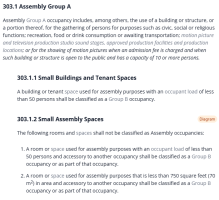When a break room in an office is over 750 SF I historically have always classified it as A-2. The 2024 IBC 508.2.1 Occupancy classification in the commentary says "make this area a lunchroom (A-3)." Do we think this is a typo and they mean A-2? I checked previous versions of the code in the same section and they say a lunchroom is A-2.
I appreciate your input!
I appreciate your input!



